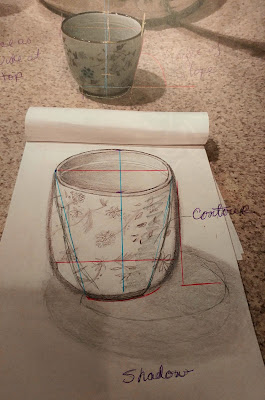Not at all pleasant.
 However, the sun room has been just that. Sunny. I love working there in natural light. So with the help of many bunches of roses I am working on several still life drawings/paintings in Colored Pencil.
However, the sun room has been just that. Sunny. I love working there in natural light. So with the help of many bunches of roses I am working on several still life drawings/paintings in Colored Pencil.These orange roses present a real challenge. Orange is not an easy color to work with, and getting all the small shade differences in them to make the roses seem real is not easy. Something that is also presenting a challenge is the leaves. So many minuet value changes. How to work with them and have them come out as leaves, not just blobs of green.
Like all drawings the initial stages makes one wonder why you started this and if anything will come of it.
 I first used erasable pencils to draw it in. Orange for the roses and stems and white for the vase. Using a light touch so as not to inscribe the surface of the paper.
I first used erasable pencils to draw it in. Orange for the roses and stems and white for the vase. Using a light touch so as not to inscribe the surface of the paper.I am working on Colourfix paper, in a neutral gray/blue. This surface has a sanded tooth, much like pastel paper. It can be hard on pencils, but it does hold many, many layers of colored pencil. It is also very durable and allows both blending and burnishing. It will also take many applications of solvents, whether you use mineral spirits or a blending pen. Not all papers do. Some are much more delicate and cannot take multiple layers.
One of the first things I did was try and locate the highlights of the flowers and leaves and underpaint them with white. This way, when I add the orange these areas will naturally be lighter than the rest of the leaves and petals. I also used crimson red on my darker areas of petals and purple on the darker areas of leaves and stems.
I do know that the vase and the distortion of the stems in water are going to give me fits, but if there is no challenge, is there any point in continuing?









